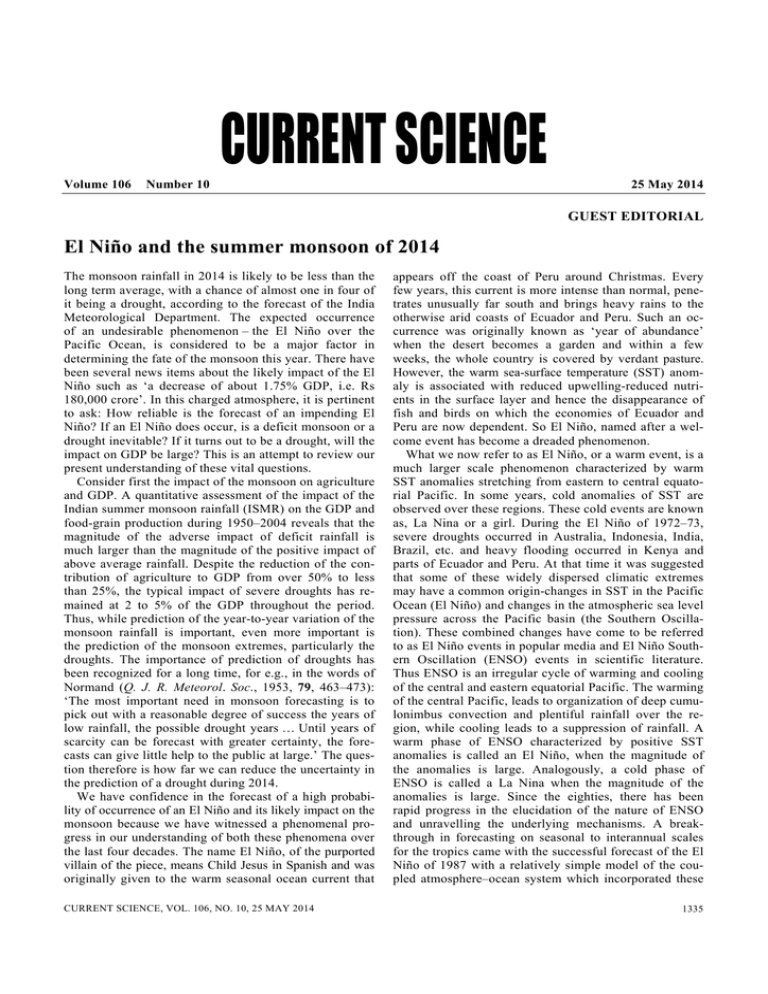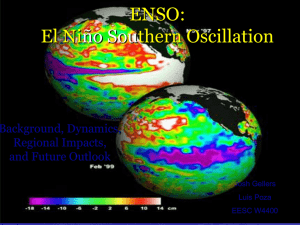CURRENT SCIENCE El Niño and the summer monsoon of 2014 GUEST EDITORIAL
advertisement

CURRENT SCIENCE Volume 106 Number 10 25 May 2014 GUEST EDITORIAL El Niño and the summer monsoon of 2014 The monsoon rainfall in 2014 is likely to be less than the long term average, with a chance of almost one in four of it being a drought, according to the forecast of the India Meteorological Department. The expected occurrence of an undesirable phenomenon – the El Niño over the Pacific Ocean, is considered to be a major factor in determining the fate of the monsoon this year. There have been several news items about the likely impact of the El Niño such as ‘a decrease of about 1.75% GDP, i.e. Rs 180,000 crore’. In this charged atmosphere, it is pertinent to ask: How reliable is the forecast of an impending El Niño? If an El Niño does occur, is a deficit monsoon or a drought inevitable? If it turns out to be a drought, will the impact on GDP be large? This is an attempt to review our present understanding of these vital questions. Consider first the impact of the monsoon on agriculture and GDP. A quantitative assessment of the impact of the Indian summer monsoon rainfall (ISMR) on the GDP and food-grain production during 1950–2004 reveals that the magnitude of the adverse impact of deficit rainfall is much larger than the magnitude of the positive impact of above average rainfall. Despite the reduction of the contribution of agriculture to GDP from over 50% to less than 25%, the typical impact of severe droughts has remained at 2 to 5% of the GDP throughout the period. Thus, while prediction of the year-to-year variation of the monsoon rainfall is important, even more important is the prediction of the monsoon extremes, particularly the droughts. The importance of prediction of droughts has been recognized for a long time, for e.g., in the words of Normand (Q. J. R. Meteorol. Soc., 1953, 79, 463–473): ‘The most important need in monsoon forecasting is to pick out with a reasonable degree of success the years of low rainfall, the possible drought years … Until years of scarcity can be forecast with greater certainty, the forecasts can give little help to the public at large.’ The question therefore is how far we can reduce the uncertainty in the prediction of a drought during 2014. We have confidence in the forecast of a high probability of occurrence of an El Niño and its likely impact on the monsoon because we have witnessed a phenomenal progress in our understanding of both these phenomena over the last four decades. The name El Niño, of the purported villain of the piece, means Child Jesus in Spanish and was originally given to the warm seasonal ocean current that CURRENT SCIENCE, VOL. 106, NO. 10, 25 MAY 2014 appears off the coast of Peru around Christmas. Every few years, this current is more intense than normal, penetrates unusually far south and brings heavy rains to the otherwise arid coasts of Ecuador and Peru. Such an occurrence was originally known as ‘year of abundance’ when the desert becomes a garden and within a few weeks, the whole country is covered by verdant pasture. However, the warm sea-surface temperature (SST) anomaly is associated with reduced upwelling-reduced nutrients in the surface layer and hence the disappearance of fish and birds on which the economies of Ecuador and Peru are now dependent. So El Niño, named after a welcome event has become a dreaded phenomenon. What we now refer to as El Niño, or a warm event, is a much larger scale phenomenon characterized by warm SST anomalies stretching from eastern to central equatorial Pacific. In some years, cold anomalies of SST are observed over these regions. These cold events are known as, La Nina or a girl. During the El Niño of 1972–73, severe droughts occurred in Australia, Indonesia, India, Brazil, etc. and heavy flooding occurred in Kenya and parts of Ecuador and Peru. At that time it was suggested that some of these widely dispersed climatic extremes may have a common origin-changes in SST in the Pacific Ocean (El Niño) and changes in the atmospheric sea level pressure across the Pacific basin (the Southern Oscillation). These combined changes have come to be referred to as El Niño events in popular media and El Niño Southern Oscillation (ENSO) events in scientific literature. Thus ENSO is an irregular cycle of warming and cooling of the central and eastern equatorial Pacific. The warming of the central Pacific, leads to organization of deep cumulonimbus convection and plentiful rainfall over the region, while cooling leads to a suppression of rainfall. A warm phase of ENSO characterized by positive SST anomalies is called an El Niño, when the magnitude of the anomalies is large. Analogously, a cold phase of ENSO is called a La Nina when the magnitude of the anomalies is large. Since the eighties, there has been rapid progress in the elucidation of the nature of ENSO and unravelling the underlying mechanisms. A breakthrough in forecasting on seasonal to interannual scales for the tropics came with the successful forecast of the El Niño of 1987 with a relatively simple model of the coupled atmosphere–ocean system which incorporated these 1335 GUEST EDITORIAL mechanisms. A major international programme to study the coupled atmosphere–Pacific ocean system, with a dense network of special observational platforms in the equatorial Pacific was set up and models were developed to a level at which they could simulate the phenomenon realistically. In early eighties, it was shown that there is a link between the interannual variation of the monsoon rainfall and ENSO over the Pacific with an increased propensity of droughts during El Niño and of excess rainfall during La Nina. Various indices depending on the SST anomalies over eastern or central Pacific are used as indicators of the phases of ENSO. Here an ENSO index based on the SST anomaly of the equatorial east-central Pacific, the so-called Nino 3.4 region (5°N–5°S, 120°–170°W), which has the highest correlation with ISMR, is used. An El Niño event is defined to be that characterized by a positive Nino 3.4 SST anomaly larger than one standard deviation. ISMR is significantly correlated with this ENSO index, with the relationship explaining 29% of the variance of monsoon rainfall. The monsoon–ENSO link is manifested as a negative correlation of ISMR with the rainfall over the equatorial central Pacific. Thus the warm phase of ENSO, which is characterized by enhancement of the rainfall over the equatorial central Pacific, is associated with a decrease in Indian rainfall and hence unfavourable. El Niño, characterized by larger amplitude anomalies, is even more unfavourable. Let us examine the implications for the summer monsoon of 2014. By April this year, the warm phase of ENSO has already commenced with enhanced convection/rainfall over the central Pacific and all the models predict that it will amplify and persist until the end of the summer monsoon. However, the predictions of the amplitude that the warm anomaly will attain, vary a great deal amongst different models and there is some uncertainty about development of an El Niño. By mid-June we should get a better idea, of whether an El Niño is imminent. An analysis of the historical data can shed light on the expected impact of an unfavourable ENSO phase and El Niño on the probability of occurrence of different categories of monsoon rainfall (such as normal, drought, etc.). The impact is found to be largest for the chance of the extremes of monsoon rainfall, i.e. droughts and excess rainfall seasons. In 2014, an unfavourable ENSO phase is expected, implying probability of drought of a little over 30%. If an El Niño does develop, the chance of a drought increases to 70%. In the event of an El Niño developing during the season, the uncertainty in whether a drought will occur can be reduced by examining the monsoon rainfall for all the identified El Niño events. Nine such El Niño events have occurred since 1958. Of these, seven were associated with deficit rainfall, six of them being droughts. However, the monsoon rainfall was above average in 1963 as well as during the strongest El Niño event of 1997. We need to understand why the sign of the ISMR anomaly was opposite to that expected from the monsoon–ENSO 1336 link in these two years. The explanation involves another mode, closer to home, called the Equatorial Indian Ocean Oscillation (EQUINOO). In 2003, it was discovered that in addition to ENSO, EQUINOO plays an important role in the interannual variation of ISMR. EQUINOO involves a see-saw between a state with enhanced rainfall over western equatorial Indian Ocean and suppressed rainfall over eastern equatorial Indian Ocean (favourable phase) and a state with opposite signs of east-west rainfall anomalies. The interannual variation of the Indian monsoon is significantly correlated with EQUINOO with the relationship explaining about 19% of the variance of the monsoon rainfall. Since, during the summer monsoon season, ENSO and EQUINOO are poorly correlated, the links of the monsoon with these two modes together explain about half of the total variance of the monsoon rainfall. Thus, the fate of the monsoon appears to depend to a large extent on whether the phases of ENSO and EQUINOO are favourable or unfavourable. In the six drought seasons, EQUINOO was unfavourable, thereby reinforcing the adverse impact of El Niño. On the other hand, the highly favourable phase of EQUINOO in 1963 and 1997, successfully overwhelmed the adverse impact of the El Niño and the monsoon rainfall was above average. Thus if an El Niño does develop in 2014, whether a drought will occur will depend on the phase of EQUINOO. Clearly, for predicting the monsoon rainfall, the models have to be capable of predicting the phase and intensity of ENSO and EQUINOO and simulating the links of these modes with the monsoon. At present, most of the state-of-the-art climate models generate reasonable predictions of ENSO, and simulate the monsoon–ENSO link realistically. However, they are neither able to predict EQUINOO nor simulate the monsoon–EQUINOO link. Evidently, concerted efforts need to be made at improving the predictions of EQUINOO and its impact on the monsoon. While ENSO has an impact on climate of the tropics as well as the mid-latitudes, the impact of EQUINOO is probably restricted to the climate of the Indian Ocean rim countries. Hence scientists in India should take the lead in addressing this challenging problem. For this, we must learn from the success story of ENSO, take up observational and modelling studies aimed at elucidating the physics of EQUINOO and focussed research on models for improvement of the simulation of EQUINOO and the monsoon–EQUINOO link. In the meanwhile, in the event of an El Niño developing during the summer monsoon of 2014, let us all hope that a favourable phase of EQUINOO will evolve to counter the adverse impact of the El Niño and prevent a drought. Sulochana Gadgil Centre for Atmospheric and Oceanic Sciences, Indian Institute of Science, Bangalore 560 012, India e-mail: sulugadgil@gmail.com CURRENT SCIENCE, VOL. 106, NO. 10, 25 MAY 2014








